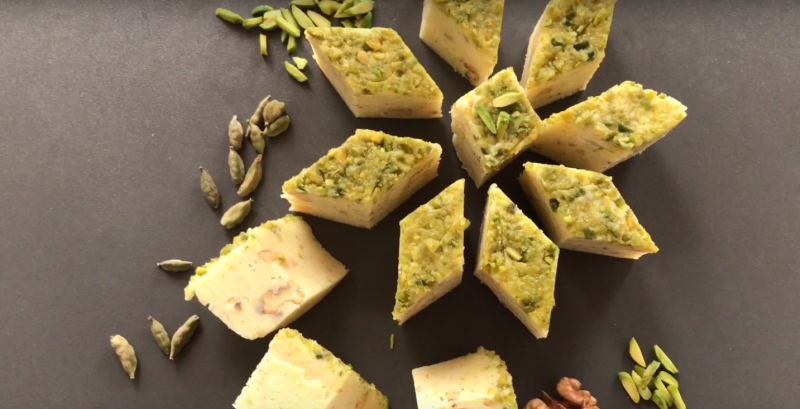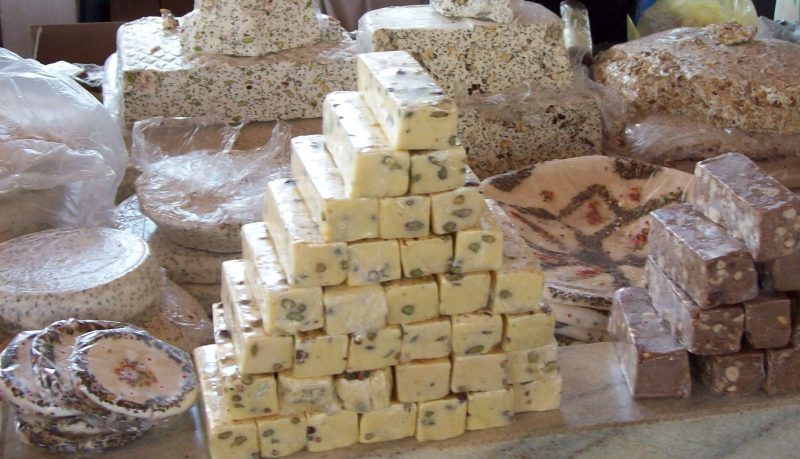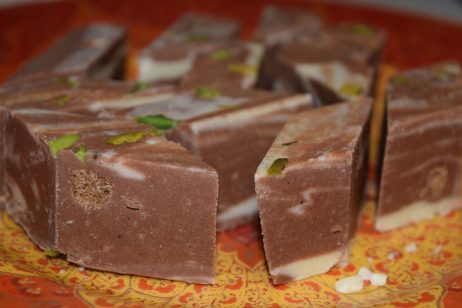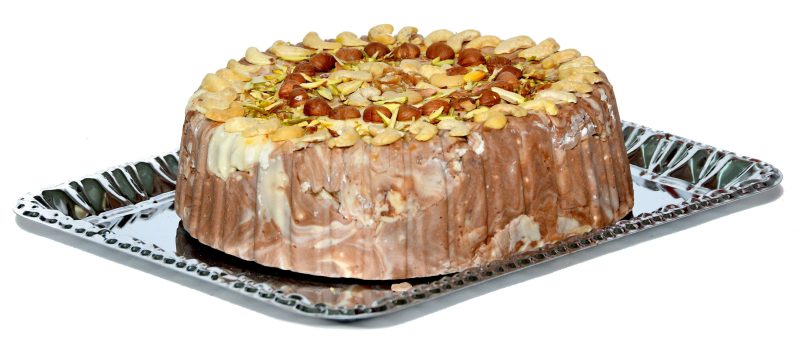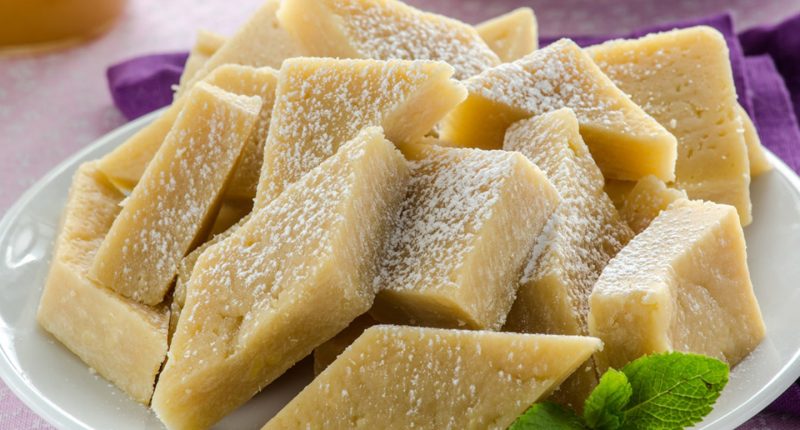Iran is considered the birthplace of halva. They say that it appeared in the Ⅴ century BC. There are a lot of varieties of this eastern delicacy. One of the most delicious is considered Samarkand halva. From ancient times, this sweet was traded on the markets of Samarkand back in those days when caravans with spices, silk and decorations slowly moved along the city streets.
Material Content:
The composition and calorie content of Samarkand halva
The Samarkand halva contains a lot of fiber, amino acids, proteins, vegetable fats, vitamins and minerals. It is quickly digested and absorbed, bringing considerable benefits to the body. This halva is also called pistachio, as it is made from this particular type of nuts. Therefore, it tastes very different from the well-known and familiar product based on sunflower seeds.
The calorie content of the Samarkand halva is quite high: 100 g of the product contains about three hundred calories.
But the exact numbers depend on the composition of the ingredients. For example, if the product contains chocolate, then the calorie content can reach 500 kcal.
Manufacturers often add additional ingredients to the product for an attractive appearance and variety. Chocolate halva is especially popular. In the shops of oriental sweets, it is sold in transparent packages of 400 g, already cut into neat pieces.
Benefits for the human body
The benefits and harms of this sweetness have long been discussed by both nutritionists and ordinary people.
Useful properties of halva:
- helps to recover after a serious and prolonged illness;
- strengthens the immune system;
- beneficial effect on brain function;
- improves the functioning of the reproductive system;
- prevents the occurrence of atherosclerosis.
Nutritionists say that the maximum allowable amount of the consumed product should not exceed 30 g per day. It is useful for athletes and people involved in hard physical or mental activities to use sweetness, as the product nourishes the muscles and brain.
How to make an oriental delicacy with your own hands
Such halva can be easily made with your own hands, as the manufacturing technology is very simple.
Classic recipe
The product, prepared according to the classic recipe, has a pleasant nutty flavor and an unusual color.
It is necessary to prepare only 4 ingredients:
- milk - 2 tbsp .;
- sugar - 300 g;
- ghee - 2 tbsp. l .;
- pistachios - 200 g.
It is better to cook a treat in a cast-iron bowl or in a saucepan with a thick bottom and walls so that nothing burns.
Cooking process:
- Pour pistachios with boiling water and leave for half an hour, so that they swell a little and absorb moisture. Then rinse, chop nuts and add them to milk.
- Introduce sugar with butter. To stir thoroughly.
- Boil. Reduce the heat and boil the mixture, stirring constantly. Milk should boil almost everything. You can add some vanilla if you wish.
- Pour the finished mass into the prepared form. Put in the cold to set. It is best to use silicone molds lubricated with oil for this purpose, in order to then avoid problems in the pulling process. If there are no such forms, the thick mass can simply be wrapped in a dense film, oiled.
Cut the frozen product into pieces. You can take a sample!
With sesame seeds
You can cook a treat on the basis of sesame. This healthy product rejuvenates the body and slows down the aging process. The main thing is to choose it correctly. Sesame should be fresh and smell good.
Necessary components:
- sesame seeds - 200 g;
- sugar - ¾ st .;
- purified water - ½ tbsp .;
- vegetable oil - 50 ml;
- flour - 1 tbsp.
Cooking:
- Grind the seeds. It is most convenient to do this in a coffee grinder. The consistency should be floury.
- Make syrup from water and sugar. Bring to a boil, stirring occasionally to completely dissolve the grains.
- Pour in oil.
- Fry the sifted flour in a clean and dry pan until creamy. Here you need to be careful: the flour is very easy to overcook, as a result of which it will become bitter and dark, which will make it unsuitable for further use.
- Combine the fried flour and chopped sesame mass. Introduce syrup and mix.
- Transfer the mass to a mold covered with parchment paper and place in a cold place for at least 3 hours.
The taste of such halva is slightly different from the classic. The color of the finished product is mustard yellow.
Cooking in Uzbek
The easiest way to cook a treat based on walnuts.
Required Products:
- peeled walnuts - ½ tbsp .;
- sesame - a handful;
- sugar - 200 g;
- flour - 130 g;
- ghee - 130 g;
- milk - 0.5 l.
Sequencing:
- Melt the butter in a skillet over low heat. Introduce pre-sifted flour and mix. Fry until the mass acquires a beautiful cream shade.
- Pour milk into another container, add sugar, mix and bring to a boil.
- Introduce milk syrup into flour in a thin stream, constantly stirring the mass.
- Fry for a quarter of an hour, then cool.
- Grind nuts with a blender or pass through a meat grinder, fry sesame seeds.
- Combine the milk and flour mass with nuts, form small neat balls.
- Roll the blanks in sesame seeds.
Halva in this form can be served instead of sweets for tea.
For a change, vanilla, pieces of chocolate, cocoa, raisins, dried fruits, candied fruits and other ingredients are often added to the mass.
Contraindications and possible harm
If you enjoy halva in reasonable quantities, it will not bring harm to a healthy person. However, it is still contraindicated in a number of cases.
This availability:
- allergies
- diabetes mellitus;
- overweight;
- tooth problems;
- diathesis;
- kidney stones or bladder.
For many chronic diseases, before using halva, it is advisable to consult a doctor just in case. It is forbidden to use the product with pancreatitis. High fat sweets will irritate the mucous membranes, causing severe pain. The pancreas and duodenum will begin to malfunction, as a result of which the patient will suffer from flatulence and diarrhea. Therefore, it is better to follow the doctor’s recommendations and there are only authorized dietary products.
In some people, eating halva can cause unpleasant side effects: heartburn, abdominal pain, and digestive upset. This happens for two reasons: either the person ate too much goodies, or he has an individual intolerance to one of the components.
Pregnancy is not a contraindication. If the expectant mother really wants sweets, it is better to give preference to halva than sweets with an incomprehensible composition. This will benefit both the mother and the baby, if you use the product in moderation. The same applies to lactating women. If the baby normally reacts to this sweetness, then the mother can from time to time regale her without any fears.
This oriental sweet can really be called useful. The most delicious, of course, will be halva, cooked with your own hands at home. Therefore, at least occasionally you need to pamper yourself and your loved ones with such a treat.


